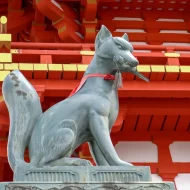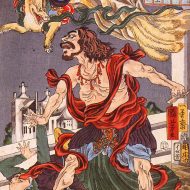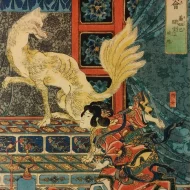Kitsune : The Japanese Fox
Listen
At a glance
| Description | |
|---|---|
| Origin | Japanese Mythology |
| Classification | Animals |
| Family Members | N/A |
| Region | Japan |
| Associated With | Shapeshifing, Trickery |
Kitsune
Introduction
Kitsune, the mischievous foxes found in the rich tapestry of traditional Japanese folklore, belong to a category of supernatural entities known as yōkai, possessing godlike powers. Renowned for their extraordinary talents, kitsune are particularly celebrated for their shape-shifting abilities. As they mature, these supernatural skills tend to intensify, making kitsune a captivating and esteemed presence in Japanese cultural traditions.
Physical Traits
Kitsune are a prevalent subject in visual art, literature, and at religious shrines. Kitsune are typically portrayed as foxes, yet they harbor the exceptional ability to assume human form, often taking on the appearance of an alluring woman. In their natural fox form, they are most commonly depicted as white, although there are instances where they appear as red foxes. The red foxes, being more prevalent in Japanese folklore, are regarded as even more potent than their white counterparts. Kitsune exhibit variability in terms of size and appearance, with certain accounts describing them as larger, ethereal beings.
The most defining physical characteristic of kitsune is the number of their tails, which signifies their age, wisdom, and strength. Kitsune can possess anywhere from a single tail to the remarkable count of nine, with each additional tail symbolizing a significant escalation in their potency. The nine-tailed kitsune, in particular, is recognized for its immense power and wisdom, often associated with divine or celestial entities.
Family
Kitsune are not traditionally affiliated with a specific family structure but are more commonly associated with the deity Inari, a prominent kami (holy spirit) in Japan’s Shintō religion. Inari is regarded as the guardian god of rice cultivation, widely believed to bestow prosperity.
Beneath the divine figure of Inari Ōkami, kitsune are organized into a familial framework. The leader of this kitsune family is typically the most potent nine-tailed kitsune, while other kitsune assume various roles, including messengers, protectors, and attendants. This hierarchical arrangement underscores the intricate interplay of kitsune within Japanese mythology and the multifaceted nature of their existence.
Other names
Although “Kitsune” is the most prevalent name for these fox spirits, their nomenclature varies according to their characteristics and the specific regions in which they are revered. In the Kanto region, they are commonly denoted as “kitsune,” whereas in the Kansai region, the name “inari” is more frequently employed. Inari shrines, dedicated to the deity Inari, serve as places of devotion and admiration where it is believed that kitsune reside. In various localities, kitsune may assume alternate identities, such as “yako,” “myobu,” or “kon,” underscoring their diverse roles and manifestations in different areas of the country.
Powers and Abilities
Kitsune are known for their diverse and extraordinary powers. One of their most notable abilities is shape-shifting, which allows them to transform into the guise of a human. This power is often associated with female kitsune, who may appear as beautiful women to interact with humans. Kitsune are also skilled illusionists, able to create convincing sensory illusions and even disguise their surroundings.
In addition to their shape-shifting abilities, kitsune possess a wide range of supernatural skills. They can manipulate fire and possess control over the elements. They are adept at both healing and harming, and their powers can be used for both benevolent and malevolent purposes. Kitsune are also known to possess the ability to possess and influence human behavior, often used to impart wisdom or cause mischief.
Modern Day Influence
The legacy of kitsune continues to influence modern-day Japan in various ways. While many aspects of kitsune mythology remain firmly rooted in tradition, their presence is still felt in contemporary culture. Inari shrines, dedicated to the deity associated with kitsune, are widespread across Japan and remain important places of worship. People visit these shrines to seek blessings for prosperity, good fortune, and protection, paying homage to the mystical foxes that are considered messengers of Inari Ōkami.
Kitsune also play a prominent role in literature, film, and popular culture. Their allure as shape-shifters and enigmatic beings has inspired countless stories and adaptations. From classic Japanese literature like “The Tale of Genji” to contemporary manga and anime, kitsune continue to captivate audiences with their allure and complexity.
The enduring influence of kitsune extends to the realm of cuisine, with various dishes named after them. Kitsune udon, for example, is a popular Japanese noodle dish that features deep-fried tofu pockets, believed to be a favorite food of the foxes. This culinary homage underscores the cultural significance of kitsune and their connection to traditional and modern Japanese life.
Related Images
Frequently Asked Questions
What is lorem Ipsum?
I am text block. Click edit button to change this text. Lorem ipsum dolor sit amet, consectetur adipiscing elit. Ut elit tellus, luctus nec ullamcorper mattis, pulvinar dapibus leo.
What is lorem Ipsum?
I am text block. Click edit button to change this text. Lorem ipsum dolor sit amet, consectetur adipiscing elit. Ut elit tellus, luctus nec ullamcorper mattis, pulvinar dapibus leo.
What is lorem Ipsum?
I am text block. Click edit button to change this text. Lorem ipsum dolor sit amet, consectetur adipiscing elit. Ut elit tellus, luctus nec ullamcorper mattis, pulvinar dapibus leo.
What is lorem Ipsum?
I am text block. Click edit button to change this text. Lorem ipsum dolor sit amet, consectetur adipiscing elit. Ut elit tellus, luctus nec ullamcorper mattis, pulvinar dapibus leo.
What is lorem Ipsum?
I am text block. Click edit button to change this text. Lorem ipsum dolor sit amet, consectetur adipiscing elit. Ut elit tellus, luctus nec ullamcorper mattis, pulvinar dapibus leo.














